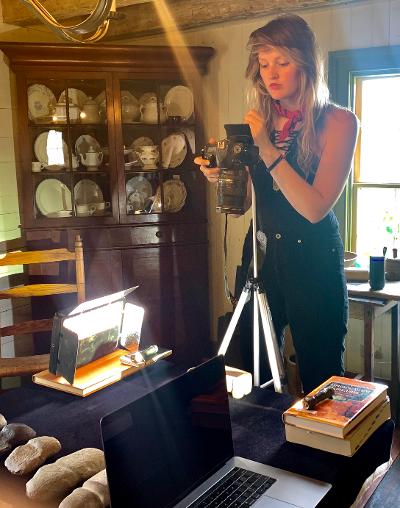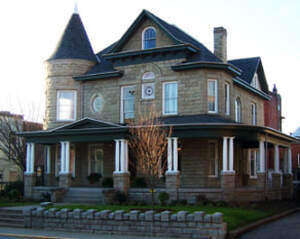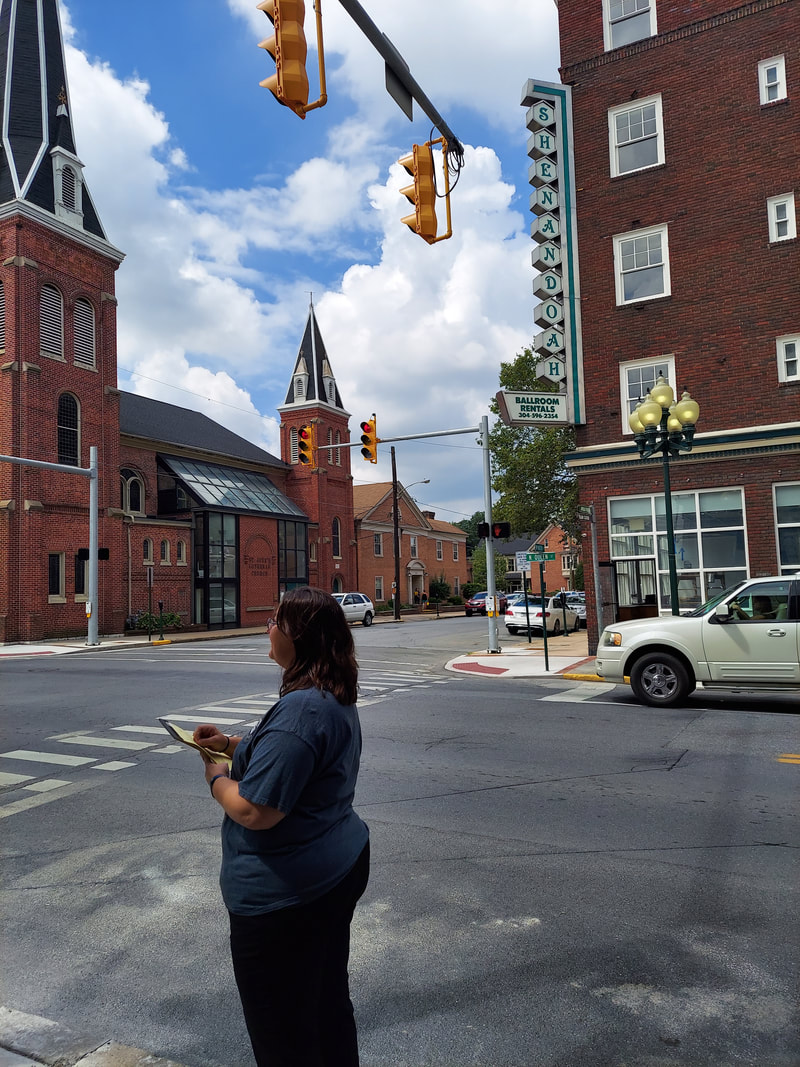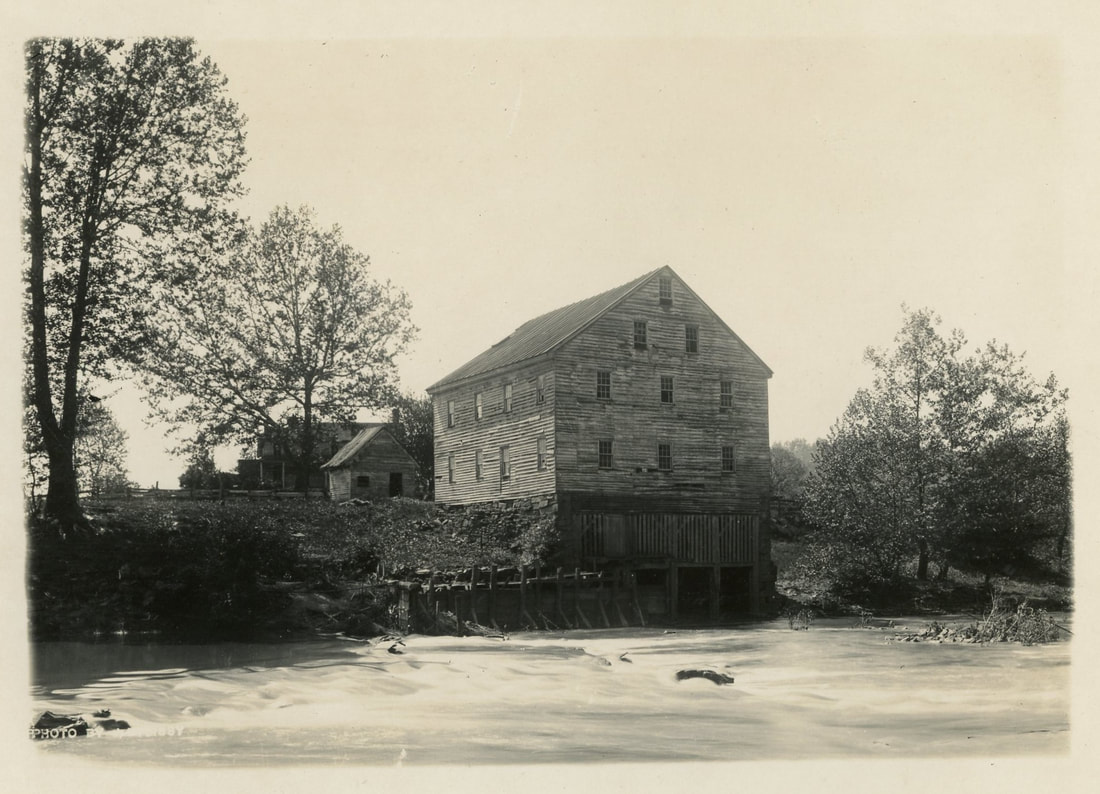names of buildings, current owners and tenants, and original construction date. During the pandemic, I was able to get out into the community and walk around to have a better understanding of the buildings to continue the building inventory and update any needed information for the inventory that was not available online. Much of the district now has been completed and includes all of the main streets that are home to many of the businesses and historic homes. The COVID-19 pandemic caused the museum that the Berkeley County Historical Society has to close. During this time, it provided time for the society to change and update a few exhibits. One of the exhibits that I was able to work on was one of the schools in Berkeley County. This exhibit provides an historic resource improvement to visitors especially now during the pandemic because it provides a glimpse of how different schools looked like not long ago. The exhibit focuses on how schools in Berkeley County looked like from the late 1800s until the 1950s. The exhibit includes photos of the smaller one room schools, school activities, class photos and school schedules that reflect that time-period. Due to the pandemic and how schools as we know them are currently changing, this exhibit may help remind the audience of the evolution of schools. The historic resource improvement for both sites can help both sites in current and future historic preservation efforts by having some groundwork completed and available. Due to the Covid-19 pandemic, the Downtown Martinsburg Historic district may evolve with the change in business, but the current inventory can provide some background information on the buildings. The school exhibit is a reminder that schools have evolved in the past and the information may help in the transformation in how schools evolve now due to the pandemic. Susan CrowellSusan served in the Preserve WV AmeriCorps program during the 2019-2020 program year. She served at two sites during her term: Main Street Martinsburg and the Berkeley County Historical Society. Hinton’s oldest standing residential structure, The Campbell Flannagan Murrell House Museum, built circa 1875, has recently gone through more than the obvious face lift. This current day museum has also received lots of much needed preservation attention and preventative maintenance.
In June of 2017, the former Preserve Alliance of West Virginia’s AmeriCorps Member, Sarah Rogers, submitted a (successful) National Coal Heritage Area grant in hopes to address the concerns of the safety of the CFM House and to preserve the structure and its contents. Combined with that, Candice Helms, the current PAWV AmeriCorps Member, submitted a mini grant through the Hinton Area Foundation to fund the painting of the exterior. The City also contributed their labor to doing a majority of the work. In September 2019, the project started and successfully ended in July 2020. Jumping in after Sarah left, was quite seamless. The entire Board of the Museum has been very supportive and excited as Candice was to see a much needed, finished product. A staple in the repair process was the installation of a much needed retaining wall. Water damage issues were in abundance with this Historic structure, and redirecting the water away was just the beginning of the process. Tree removal, installation of supplemental guttering, and equipping a dehumidifier in the basement were also needed to complete that effort. Throughout the house there were windows that needed attention, walls in need of patching, flooring to be replaced, and much more. Lastly, the entire house was painted to what the Museum Board deemed as the most accurate, original color scheme. Hinton is coming around the bend full force in Community Development and this project is just one of the many to consider successfully done! We are very proud of this new, shining beam in the West End and every passer-by gets greeted with a lovely sight, and all who put in any effort, receives a reminder that it takes a village to keep moving forward, FULL STEAM AHEAD!  The Monroe County Historical Society has been fortunate to have a volunteer conservator to work with us for a few weeks photographing the Native American artifacts in our collection. While vacationing in the Area, Ms. Devlin Cyr Wallace stopped by to visit the museum and ask about the Native American heritage of the area. After reviewing our books and record on the subject, she was interested in viewing our artifacts, and after learning that the museum had a project to photograph items in its inventory, Wallace volunteered to work with the artifacts. Devlin Cyr Wallace is a 2019 photography/videography graduate of the NYC School of Visual Arts, a member of the NYC Explorers Club, the National Speleological Society, and the Greenbrier Grotto. She had also taken classes in Native American archeology in Kentucky. Photographing the artifacts provides an opportunity for her to dovetail both her interest in the subject and her skill set. Wallace hopes her visual documentation of the Society’s Native American collection will attract attention and interest to the area’s rich Native American history which has yet to be fully explored. She will also benefit by using this experience to expand her professional portfolio. VERNESSA PONTIUSVernessa is to the 19-20 Preserve WV AmeriCorps member serving with the Monroe County Historical Society. Vernessa is responsible for volunteer management at the historical society, in addition to museum cataloging, exhibit development, and outreach. Marilyn Creager, an AmeriCorps Member with the Preservation Alliance of West Virginia's Preserve WV AmeriCorps program, has partnered with the West Virginia Mask Army to sew masks for the public and for Pocahontas County’s healthcare workers. Creager is currently placed in an AmeriCorps position at the Pocahontas County Opera House and has been supporting the Opera House through help with social media marketing, grant writing, historical research, and event planning. However, due to the COVID-19 pandemic, Creager has switched gears to help her local community with COVID-19 relief.
“Sewing masks made me feel better about everything that was happening. Being stuck at home made me feel helpless, and I wanted to do something,” Creager said. “The Opera House is located in a fantastic community, and I wanted to continue helping people directly.” The head of the Potomac Highlands mask hub, Kim Musser, stated that the mask army is something special to her. Once Creager joined the team, she was able to add Pocahontas County to the Potomac Highlands mask hub and make it the largest hub in the West Virginia Mask Army, which was serving over six counties.
“Very quickly, I grew, to the point where I realized that I couldn’t take on just my county alone—being Grant county—so I became Potomac Highlands, which encompasses Grant, Hardy, Pendleton, Mineral, and Hampshire,” Musser said. “Then, the Potomac Highlands became the Eastern Panhandle once [Creager] joined in... We just grew and grew and grew.” The Mask Army expanded its operations as time went on and is now switching gears to put masks on the faces of the community, rather than just healthcare workers. Each hub has a different priority. Creager is making and distributing GoreTex face shields and is distributing them through Community Care of West Virginia in Marlinton and Green Bank, as well as some through the Deer Creek Clinic in Green Bank, West Virginia. Overall, Creager’s experience with the West Virginia Mask Army has made her feel more connected to the state. “Because we have all had to work together to flatten the curve—to varying success—and because there were so many volunteers working with the West Virginia Mask Army to help the state, I felt more connected to the state than I have in a long time. It feels special to be involved with such an amazing group that helped when help was few and far in between,” Creager said. Musser agrees. “I met so many friends, [Creager] included, throughout the state, and I am just so proud of the state and how we all came together,” she said. So, as this public health crisis continues, Creager is currently looking for volunteers to continue the sewing project to help community members in Pocahontas County while the state adjusts to the current reality. If you would like to participate, please email Creager at marilyn@pocahontasoperahouse.org and she can discuss volunteering with you. For more information about the West Virginia Mask Army, please visit https://sites.google.com/view/wv-mask-army/home.  In the spring semester of 2019, Jennifer Thornton, an assistant professor of public history at West Virginia University, contacted Nicole Dias of BAD Buildings and the Northern WV Brownfields Assistance Center and asked her if she would like to give a guest lecture to her historic preservation class. Nicole agreed and included me, the Preserve WV AmeriCorps member serving at BAD Buildings, into the project. We created a presentation on BAD Buildings and our work with abandoned school buildings across the state. The guest lecture went over well with both Professor Thornton and her students. For the rest of the semester Jennifer and her students remained in contact with us, sending us questions and information about abandoned schools they did projects on. With the success of our first guest lecture, in January 2020, Professor Thornton contacted Nicole and I to do another guest lecture for her spring 2020 historic preservation class. We scheduled the guest lecture to take place in April. With the outbreak of the COVID-19 pandemic, the plans for the guest lecture seemed uncertain. However, Jennifer Thorrnton assured us that the guest lecture will go on as planned, except it would be done through zoom. We would be able to share our presentations through screen share and talk to the students. Nicole and I split the guest lecture into two parts. Nicole would give the basics of the BAD Buildings program while I would give the basics of the Preserve WV AmeriCorps program and how historic preservation is connected to BAD Buildings. Since this is my last year as a Preserve WV AmeriCorps member, I wanted to share my experiences with the class and encourage them to look into becoming a Preserve WV AmeriCorps member post graduation. Additionally, Nicole and I wanted to give the students a lesson that lets them know that historic preservation is not only important for history, it is important for a community's redevelopment. There are a lot of benefits to historic preservation and we wanted to share them with the students to encourage them to continue this path in their professional careers. Despite not having given a lecture through zoom before, thankfully our guest lecture was a success without any technical errors during the presentations. The students were well behaved and Professor Thornton added insightful comments. At the end, several students asked questions indicating that they were engaged with the lecture despite the circumstances. Unfortunately, at the very end of the guest lecture the zoom audio started to malfunction so we had to call the class to a close. The next day, Professor Thornton thanked us again through email and told us, “I was worried that with the COVID-19 quarantine the students would miss out on the guest lectures. I appreciate that you were committed to making it work despite these challenges!” It was great to work with Professor Thornton again and share our experiences with a new group of students. SUMMER PHILLIPSSummer Phillips is the Preserve WV AmeriCorps service member with the BAD Buildings program at the Northern WV Brownfields Assistance Center. She began her service in 2018 and it will conclude in August 2020. If you are interested in volunteering during the COVID-19 crisis or are in need of help, visit these resources: Rapid Response WV - https://rapidresponsewv.org/ Volunteer WV - https://volunteer.wv.gov/Volunteer/Pages/Covid-19.aspx
On Friday March 20th, we had a small group of volunteers which included middle and high school students. We set up an assembly line and implemented social distancing by keeping ourselves apart, washing our hands, and being careful about not touching any switches and door handles. We made 322 emergency food boxes. On Saturday March 21st, we only had four people, including fellow AmeriCorps member Morgan Agee who normally serves at Trout Unlimited under the Appalachian Forest National Heritage Area. Despite the small number, by the end of the day we were still able to prepare 82 emergency food boxes for the needy. It was hard work but we felt a real sense of accomplishment looking at the finished boxes ready to be loaded onto trucks! I learned what a complicated logistical operation a food bank is! Imagine when you get a call and are offered two truckloads of Fruit Loops; you don't want to say no, but you have to figure out where to store them and how to work them into your food rotation. The director Kathryn Porter is extremely well organized and deals with this type of issue every day. She is a practical problem solver of the first degree – think of a cross between a drill sergeant and an elementary school teacher and throw in some humor as well because you must have some fun too!
If you are interested in volunteering during the COVID-19 crisis or are in need of help, visit these resources: Rapid Response WV - https://rapidresponsewv.org/ Volunteer WV - https://volunteer.wv.gov/Volunteer/Pages/Covid-19.aspx Ksenia BradnerPreserve WV AmeriCorps member serving with the Preservation Alliance of West Virginia. During Jessi Hersom’s service term as a Preserve West Virginia AmeriCorps member she had the opportunity to give visitors personalized experiences during tours of the historic district at Jackson’s Mill. This summer she led a personalized tour for a family who homeschooled their children, that went along with their current school lessons.
This family decided to visit the Jackson's Mill Historic area as a field trip relating to their recent lesson about 19th century homesteads and farms. They were particularly interested in seeing the McWhorter Cabin, which was originally constructed in the 1790s by Henry McWhorter near Jane Lew, West Virginia and was relocated to Jackson’s Mill in 1927 for preservation purposes. This cabin is part of the historic area at Jackson's Mill and is set up to display how a home would have looked in the early nineteenth century. The family was particularly interested in the fireplace and chimney and its role as the kitchen and how these elements connected to the neighboring garden and gristmill. They were given a full tour of the historic homestead after their specialized tour of the McWhorter Cabin, where they could see how the farm buildings and other components of the Jackson family business supported the Jacksons, who originally lived in a cabin that was similar to the McWhorter Cabin. Jessi Hersom located specific examples of photos of the McWhorter Cabin from the Jackson’s Mill archives so the family had references during their tour, which also aided in providing an experience that was unique to their needs and educational. They greatly appreciated their time Jackson’s Mill and benefitted from the chance to have a hands-on experience in a nineteenth century cabin and shared that they would be visiting again in the future. As the Preserve West Virginia AmeriCorps member at Jackson’s Mill, Jessi Hersom led tours of the historic area at and led demonstrations that included operating the historic grist mill and working blacksmith shop during special events. During her term she also continued projects in the Jackson’s Mill archives. Creating electronic records, rehousing, locating and organizing items, inventorying, and processing new documents are some of the activities that are essential in order to maintain the archive. The continuation of digitally inventorying these historic items is vital to preservation and processing items and photographs allows for future access to those who are interested in the site’s history. Several visitors directly benefited from this project by having access to historic documents that were otherwise inaccessible. On one occasion, a visitor requested any photos from the early days of the state 4-H camp at Jackson’s Mill, when his father was attending during the nineteen forties. Jessi was able to provide him with several dozens of images from this time period. He was then able to reference these images during his visit to Jackson’s Mill and could compare the historic photographs to the current status of the camp. The archives are also essential for research and can be used as a tool for referencing primary sources regarding the Jackson’s Mill historic area and State 4-H Camp. Items in the archives are referenced regarding any new publications about the site and will be used for new signs and markers that will be created to aid visitors during self-guided tours. The 4-H Camp at Jackson’s Mill will be celebrating its one hundredth anniversary in 2021, and these documents will be vital for the research needed for future publications regarding this event. Being able to provide guests with data from the archives supplements their visits and allows for a more satisfying and comprehensive learning experience and will also help people understand Jackson’s Mill in its historic context. These improvements may also allow for an increased interest in the site and help boost attendance in the coming years. I have completed a number of projects as an AmeriCorps member for the history app and website Clio, which aims to provide a digital museum for the country where users can read encyclopedia-style entries on historic sites and institutions across the United States and engage with various forms of media. These projects have taken the form primarily of walking and driving tours, among them walking tours of historic Berkeley Springs, in Morgan County, Beverly, in Randolph County, and the Evansdale Campus of West Virginia University in Morgantown. Perhaps my favorite, however, is a driving tour following the historic progress of the Jones-Imboden Raid of 1863, during which the Confederate military made a last-ditch effort to prevent the formation of West Virginia as a state separate from Virginia. The tour follows the campaign as it made a great loop from what is now the western edge of Virginia into Union-held territory and back once more into the Confederacy. In the process, users learn not only of the military situation in 1863 but of the political, economic, and social factors that helped to determine the loyalties of those involved not only before and during but after as well. Users are also treated to a number of interesting and entertaining stories from the campaign and can peruse a selection of videos, photos, and online resources related to the history of the raid and West Virginia’s relationship to the larger Civil War. Led by Confederate Generals William E. “Grumble” Jones and John D. Imboden, the Jones-Imboden Raid of 1863 had a number of strategic goals. Most immediately, it sought to sabotage the operation of the Baltimore and Ohio Railroad in the region (a key thoroughfare for Union goods and personnel from east to west) and disrupt the proceedings of the pro-Union government there. In less direct terms, however, it also aimed to gather important supplies for the beleaguered Army of Northern Virginia by begging, buying, and stealing as much livestock and food as possible and requisitioning horses for the perennially ill-supplied Confederate cavalry. Finally, with General Robert E. Lee hoping to confront and defeat the Army of the Potomac under General Joseph Hooker, the Confederates hoped to prevent reinforcements from arriving from the west to interfere with Lee’s plans in the east. Of those goals, only the last two were truly accomplished. Jones and Imboden funneled a considerable amount of supplies, livestock, and mounts back to the east and in the Battle of Chancellorsville that occurred during their raid, Lee decisively defeated Hooker in open conflict. While the raiders did manage to destroy significant portions of the B&O Railroad, though, trains were back up and running within a few months after hasty repairs. The goal of disrupting Union governance in the region failed entirely, and the raiders managed to alienate many in the areas they traveled through by their treatment of the local populace. West Virginia statehood became a reality shortly after the raid’s conclusion. Users can learn even more about the raid, its causes, and its consequences in the driving tour I’ve created on Clio. Nathan WuertenbergNathan served as a Preserve WV AmeriCorps member at the Clio Foundation during the 2018-2019 term.  For my Civic Service Project as an AmeriCorps member with the Preservation Alliance of West Virginia and the history app and website Clio, I helped lead volunteers in organizing a collection of historic newspapers and documents held at the Aull Center for Local History and Genealogy Research. Opened in 2004 as an annex of the Morgantown Public Library in the historic home of the Garlow family, the Aull Center contains a unique collection of primary and secondary resources related both to the history of Morgantown, Monongalia County, and West Virginia and genealogy of local families. This collection began on the second floor of the Morgantown Public Library next door but moved to the Garlow home in order to accommodate its continued expansion. The opening of the Aull Center resulted in the collection’s tripling in size. Within this collection is an assortment of historic newspapers and other documents in a filing cabinet on the second floor. This particular collection began life on the second floor the library as a keystone of the historical collection there but became disorganized in its transportation to the Aull Center and has since languished. Without the staff necessary to both operate the Aull Center on a daily basis and reorganize this collection patrons have been unable to benefit from the historical resources and knowledge held within it, once such a key part of the research capacity of the library’s historical records. In the hopes that patrons might once again be able to benefit from the information in this collection, I helped to lead a small group of volunteers in cataloging, organizing, and when necessary more suitably preserving the documents in the first drawer of the filing cabinet that holds it. Over the course of three hours, we were not only able to complete our task, but enjoy the many interesting and enlightening documents across which we came. As they sought to bring order to this drawer in the collection, volunteers learned about the early industrial history of the city of Morgantown, the construction of the Morgantown and Kingwood Railroad, the early life of the Morgantown Public Library itself, and an episode during the Cold War when a West Virginia mayor invited Soviet officials to his town to complete the construction of a local bridge. Volunteers were also able to locate several resources for which Aull Center staff had been searching for some time, including a map of archaeological and historic sites in Monongalia County. In all, the volunteers organized over two dozen file folders of documents in the drawer. With their help, Aull Center staff will now be able to better serve their patrons by providing access to more in-depth and extensive research materials than was before available. Without the help of the volunteers in the Civic Service Project, this would not have been possible. The staff and patrons of the Morgantown Public Library and Aull Center for Local History and Genealogy Research thus owe a considerable debt to AmeriCorps and the volunteers who assisted in the project. NATHAN WUERTENBERGNathan served with the Clio Foundation as a Preserve WV AmeriCorps member during the 2018-2019 term. |
Preserve WV StoriesCategories
All
Archives
August 2023
|
Get Involved |
Programs |
Contact UsPreservation Alliance of West Virginia
421 Davis Avenue, #4 | Elkins, WV 26241 Email: info@pawv.org Phone: 304-345-6005 |
Organizational Partners:
© COPYRIGHT 2022 - PRESERVATION ALLIANCE OF WEST VIRGINIA. ALL RIGHTS RESERVED.













 RSS Feed
RSS Feed



